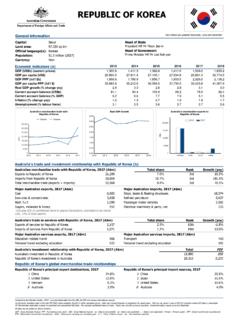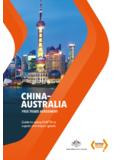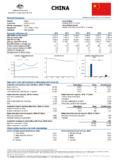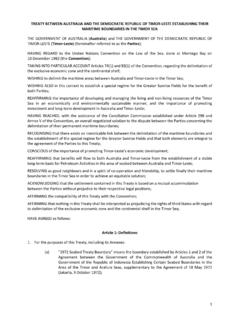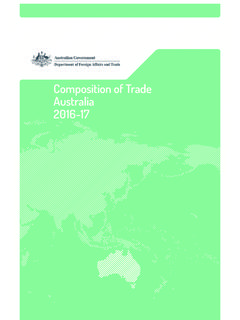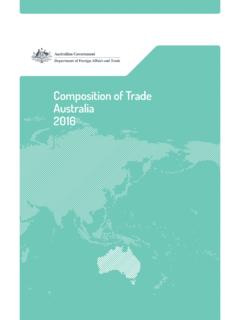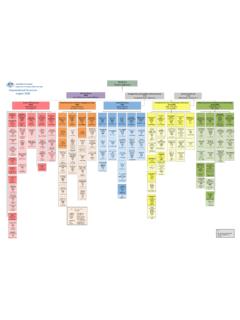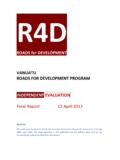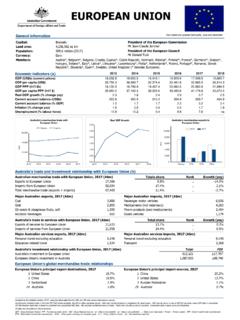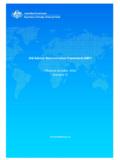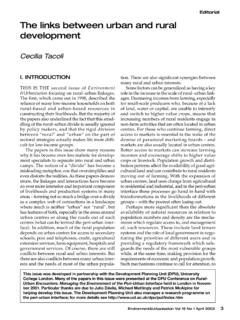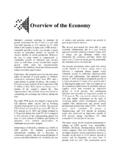Transcription of Aid Investment Plan - Department of Foreign …
1 Aid Investment plan Pacific Regional 2015-16 to 2018-19. Strategic priorities and rationale This Aid Investment plan sets the strategic framework for the provision of Australian Official Development Assistance (ODA) administered by the Department of Foreign Affairs and Trade (DFAT) to regional initiatives in the Pacific. Australia implements an integrated set of Foreign , trade, security and development policies to advance our interests in the Pacific. It is in Australia's interest to support the Pacific region's development and economic prosperity. The Pacific Regional Program complements our Pacific bilateral programs in support of a stable, secure and prosperous Pacific. The Program supports regional approaches to address a range of regional development and economic growth challenges.
2 Geographic isolation and small and dispersed populations make the delivery of even basic goods and services logistically difficult and expensive. Natural disasters and economic shocks hinder economic development. Little progress has been made toward the Millennium Development Goals, and the private sector is typically small with large informal economies. Violence, a lack of women in leadership roles and constrained financial opportunities limit women's economic participation. The benefits in addressing these shared challenges collectively make regional approaches an important complement to Australia's bilateral programs. The Pacific Regional Program's investments leverage economies of scale that individual country programs lack, enabling them to draw on a greater expertise base and resources.
3 At $166 million around 20 percent of DFAT's aid to the Pacific the Pacific Regional Program advances Australia's strategic interests by supporting economic growth, effective regional institutions, healthy and resilient communities and the empowerment of women and girls. The Program is delivered primarily through existing regional organisations, such as the University of the South Pacific, which provide more cost effective services when delivered regionally, particularly to the smaller states. Regional context The Pacific region continues to experience significant economic, social and environmental challenges. While extreme poverty defined as the proportion of the population living below US$ a day is rare in the Pacific, poverty remains a big challenge for many countries.
4 Over 20 per cent of people in most Pacific island countries live in hardship and are unable to meet their basic needs. 1 Many people not currently in severe hardship remain vulnerable to falling into hardship due to economic and environmental shocks. The region is particularly prone to disasters including cyclones, severe storms, flooding and earthquakes. People with a disability are among the poorest and most marginalised of their communities. In much of the Pacific, economic growth is not keeping pace with population growth. 2 Distance and weak infrastructure makes international trade expensive, but small domestic markets and narrow production bases mean countries rely on it for income and consumption.
5 Narrow production bases and imported fuel supplies also make most Pacific island countries particularly vulnerable to commodity price fluctuations. Inefficient and burdensome regulation, weak contract enforcement, limited access to finance, and low skilled and unhealthy 1. vulnerability-pacific-island-countries. 2. World Bank, World Development Statistics 2015. 2 Aid Investment plan workers make the business environment challenging. Greater regional trade and economic integration, including through the Pacific Agreement on Closer Economic Relations (PACER) Plus, is needed and will bring benefits. Progress towards empowering women is slow. Up to 60 per cent of women and girls have experienced violence at the hands of partners or family members.
6 3 The Inter-Parliamentary Union reports that globally, women comprise per cent of national parliamentarians (world average as at June 2014), but the percentage of women in Pacific parliaments currently hovers at around 5 per cent. 4 Across the Pacific, men outnumber women in paid employment (outside the agricultural sector) by approximately two to one, 5 and males typically earn 20 to 50 percent more than women because they work in jobs attracting higher salaries. 6. Australia's aid objectives In line with the Australian Government's development policy, Australian Aid: Promoting Prosperity, Reducing Poverty and Enhancing Stability, the Pacific Regional Program will complement efforts at the bilateral level to address the Pacific's economic growth challenge and reduce poverty.
7 It will do this by supporting increased economic growth, the development of more efficient regional institutions, healthy and resilient communities and the empowerment of women and girls in the Pacific. These four objectives are complementary and mutually reinforcing. We will continue to adjust the balance of our Program between these objectives, increasing support for economic growth and the development of the private sector. Objective 1: Economic growth Economic integration of the region with larger economies such as Australia is essential for sustainable economic growth. In line with DFAT's new Aid for Trade Strategy, the Pacific Regional Program will help increase Pacific trade, tourism and Investment by developing strong and resilient regional economic frameworks and by supporting the negotiation of the Pacific Agreement on Closer Economic Relations (PACER).
8 Plus trade agreement to help create an environment of growth for Pacific economies. Australia will look for opportunities for the region to benefit fully from PACER Plus, when finalised. We will promote trade, tourism and Investment through Pacific Islands Trade and Invest, and further the development of key productive sectors including cruise tourism and agribusiness. Through Australia's Seasonal Worker Programme and other regional labour mobility initiatives, we will increase the quantity and capacity of workers coming to Australia, thereby increasing opportunities for remittances. We will work to reduce the cost of remittances, including through our commitments in the G20. Responding to the Strategy for Australia's Aid Investments in Private Sector Development and the Ministerial Statement on Engaging the Private Sector in Aid and Development, we will work with corporate and multilateral partners to increase access to finance for individuals, businesses and infrastructure projects.
9 We will help remove obstacles to increased economic activity and improve the business environment, bringing innovative approaches to enterprise development. We will also improve regional economic infrastructure, with a focus on supporting transport networks where partner commitment is demonstrated. We will assist in the development of legal, governance and environmental settings to help inform consideration of sea-bed mining policies and other Blue Economy' initiatives. We will work with Pacific countries, regional organisations and the multilateral development banks to extract greater long run income streams from fisheries and agriculture by improving market access and value chain 3. E Ellsberg, B Heilman, S Namy, M Contreras and R Hayes (2012).
10 Violence against Women in Melanesia and Timor-Leste: Progress Made Since the 2008 Office of Development Effectiveness Report, International Centre for Research on Women, p. viii. 4. 5. Secretariat of the Pacific Community (2014). National Millennium Development Indicator Database. 6. AusAID (2012). Women's Economic Empowerment in the Pacific: Gender Situation Analysis, Australian Agency for International Development. Aid Investment plan 3. development. We will help Pacific farmers improve the quality of their produce and meet the biosecurity requirements and standards of Australia and other importing countries. We will also strengthen effective management of oceans through better maritime security, improve food and economic security including sustainable fishing operations in the offshore tuna operations, and improve the management of coastal and inshore fish resources.
